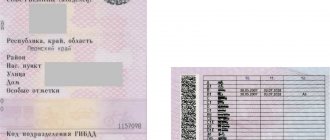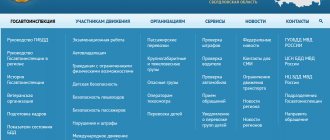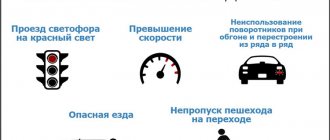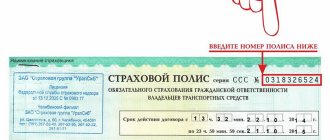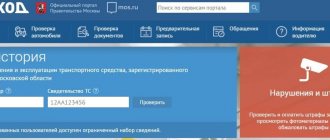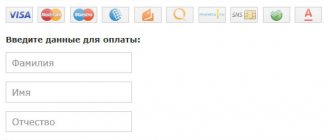What is an administrative fine?
The fine imposed for any administrative offense is almost always levied in monetary terms. The characteristics of the measure are determined by the Administrative Code:
- sanctions can be imposed both by the court and by officials and other bodies authorized to consider administrative cases;
- The minimum amount is legally established - 100 rubles, for violation of traffic rules - from 500 rubles;
- The maximum amount limit depends on the status of the offender.
- the maximum possible amount of the fine will depend on the specific composition of the Special Part of the Code of Administrative Offenses of the Russian Federation, as well as the status of the offender.
On a note! Depending on the financial situation of the offender, the authorized bodies may grant a deferment of payment of the fine for up to 3 months.
What fines are administrative?
An administrative fine, as established by the Code of Administrative Offenses of the Russian Federation, is a measure of punishment for non-compliance with labor, antimonopoly, tax, customs, land, labor, and housing legislation.
Sanctions also apply for violations of consumer rights law or other areas of law. Since recovery is carried out in cash, the following are taken into account:
- what was the administrative offense and its consequences;
- the number of similar crimes committed by the accused;
- type of entity - for individuals and legal entities, amounts may differ significantly.
Important! A fine may be imposed in conjunction with other sanctions.
According to the Code of Administrative Offenses, the only citizens for whom monetary liability is not established are conscripts of the Armed Forces and cadets of military educational institutions until the moment of signing the contract.
Sample protocol and sample resolution
In order for a protocol on an administrative offense to be recognized as valid, it must contain the information established by current legislation. The list of data that must be entered in the document is recorded in Federal Law No. 195. The list of mandatory information that must be present on the paper includes:
- date and place of registration;
- position and full name of the traffic police officer;
- information about the citizen who violated the established rules;
- date of commission of the offense and place of incident;
- norms and rights that require accountability for an action committed;
- other facts that will be useful during the proceedings.
The traffic police resolution must also comply with established standards. It reflects the following data:
- date and place of consideration of the case;
- information about the person who made the final verdict in the case;
- information about the citizen in respect of whom the document was issued;
- circumstances that were established as a result of the consideration of the case;
- reasoned decision on the proceedings;
- signatures of the participants in the proceedings.
The absence of mandatory information may result in the decision on violation of traffic rules being invalidated.
Minimum and maximum fine amounts
A fixed amount for paying an administrative fine is the basic method of punishment. The final amount of the decision will depend on:
- amounts of unpaid taxes, fees or other obligatory contributions to the state budget;
- the cost of a municipal or state contract;
- the amount of unfulfilled contractual obligations;
- cadastral valuation of real estate;
- the minimum wage without taking into account the regional coefficient at the time of the commission of the illegal act;
- the value of the object at the time of the beginning or end of the violation;
- type of persons held accountable - for individuals - 25 minimum wages, for an official - 50 minimum wages, for enterprises, regardless of the form of ownership - 1000 minimum wages.
Individual cases of financial punishment can be presented in the form of a table.
Read also: Rules for parking in courtyards
| Type of intruder | Minimum amount | Exceptions |
| Individual | No more than 5 thousand rubles. | Articles for which a larger size is provided. For example, for an infringement on freedom of conscience - 30 thousand rubles. |
| Executive | 50 thousand rubles. | Composition of offences. For example, construction work near a highway will result in a fine of 800 thousand rubles. |
| Entity | More than 1 million rubles. | Articles where a different amount is indicated. For example, for encroachment on a cultural heritage site, you need to pay 60 million rubles. |
Amount of fine for foreigners
The imposition and execution of an administrative fine for citizens of other states has several nuances:
- imposition of a fine as an additional penalty. Foreigners pay the sanction the next day after the decision. Failure to pay may result in an entry ban for 5 years;
- foreign carriers pay fines no later than the general deadline, but before the departure of their vehicles.
On a note! The court, federal (regional, municipal) officials, the Federal Tax Service, customs, and the Ministry of Internal Affairs have the right to impose penalties for an administrative offense.
When is a traffic police resolution drawn up without a protocol?
In practice, there are several cases in which a traffic police decision on a case can be issued without a protocol. This is possible in the following situations:
- The offense was recorded on photo or video cameras. Information about the need to pay a fine is sent by mail.
- If a citizen agrees with the violation that the traffic police inspector imposed on him.
- If an administrative penalty was imposed in the form of a warning or a fine at the scene of the offense. Only an authorized person has the right to perform such an action.
- The citizen does not dispute the existence of an offense.
A complete list of situations for drawing up a traffic police resolution without a protocol is enshrined in Article No. 28.6 of the Code of Administrative Offenses of the Russian Federation. A copy of the documented decision is provided against signature to the person in respect of whom it was made. If the person refuses to receive it, the paper is sent by mail. The action is carried out within 3 days from the date of the decision on the case.
How to check?
There are several ways to detect the decision and the fact of payment of an administrative fine on the subject:
- Register on the State Services website, go to the information section, click “Get a service.” Most often, the presence of a fine in the traffic police is checked by name or STS number.
- View on the traffic police website. You will need the registration number and STS of the car. You will need to go to the “Check fines” section and enter the data.
- On the FSSP website. You need to log in to the “Base of Enforcement Proceedings” service. There you can find out the debts and the amount of current payment by full name, date of birth and region.
Ways to check a fine
Important! The FSSP website will provide information if enforcement proceedings have been initiated against the debtor.
How can I pay an administrative fine?
Payment after the decision to impose an administrative fine is carried out at the traffic police, the tax office, banks, terminals. Today, Russians also use Internet services.
How long does it take to pay a fine for an administrative violation?
The Code of Administrative Offenses establishes a payment period of 60 days from the date the resolution enters into force.
The ruling document becomes valid only after the end of the appeal period. If the violator did not use the right to file a complaint, the administrative violation must be paid after 10 days. The general rule for calculating time limits is specified in Article 4.8 of the Administrative Code. This is 70 days without filing a complaint. The countdown begins on the day following the entry into force of the resolution.
Article 4.8 of the Administrative Code of the Russian Federation “Calculation of deadlines”
Where can I get the details?
The main document for paying a fine is a receipt. It is issued after the penalty has been imposed. The payment shall indicate:
- name of the financial and credit organization where the recipient has an account;
- account numbers for settlement and correspondence;
- TIN of the organization that issued the fine;
- amount to pay;
- type of administrative offense;
- Full name of the payer;
- registration address or place of residence of the offender.
Important! The receipt is proof of payment of the fine.
Sample payment receipt
How to pay an administrative fine online?
You can consider the procedure for paying a fine online using the example of Yandex.Money services. The offender acts like this:
- Logs into your e-wallet.
- Selects the “Products and Services” section.
- Clicks on the “Fines” field.
- Indicates the TIN and the name of the recipient organization.
- Enter the amount of the fine.
- Confirms the transfer of funds.
Yandex.Fines
On a note! The payment system receipt can be saved on a PC and then printed.
How to pay an administrative fine through Sberbank Online?
You can pay fines through the bank app if the payer has a payment card or current account. To deposit funds you will need:
- Go through identification in your Personal Account - enter your login and password.
- Go to the “Payments” section.
- Select the subsection “Staff Police, duties, tax payments.”
- Select the institution that issued the fine.
- Enter the details from the receipt or find the organization by TIN.
Payment via Sberbank Online
Important! Money is transferred to the recipient only after the information is verified.
How to pay an administrative fine through State Services
On the State Services website, a registered user will need:
- After logging into the portal, select a section.
- Enter the operation parameters.
- Indicate in the columns information about the administrative violation and payment.
- Click on the “Search” field.
- Select a payment method - from a bank card or e-wallet.
- Enter the required details and click “Ok”.
Payment of fines through State Services
Important! Information on liquidation of administrative liability debt will appear in the State Services database in 2 days.
How to pay an administrative fine through an ATM?
You can pay the fee for an offense at the terminal and ATM using one algorithm:
- Go to the device menu.
- Select the section “Taxes, fines, traffic police”.
- Select the desired organization.
- Specify the amount of the fine.
- Enter payer details.
- Insert money into the bill acceptor.
- Click “Ok” and pick up the receipt.
Read also: Federal Law on Communications in 2021
If you have a payment order, you can do the following:
- Find “Payments in my city” in the terminal menu.
Select "Payments in my region" - Click “Search recipient” and select “By QR code”.
- Bring the order to the scanner so that it reads the barcode.
- Confirm action.
- Deposit money and click OK.
On a note! Cardholders of a certain bank receive an SMS with a code that must be entered into an ATM or terminal.
How to pay an administrative fine without a receipt?
When the payer has lost or forgotten the receipt, you can contact the bank cash desk to pay the fine. You will need a passport, pension certificate and the name of the authority that issued the decision. The bank employee needs to be informed how much you need to pay.
On a note! If the protocol and receipt are lost, the violator can contact the institution that imposed the fine.
How to decipher the number of the traffic police resolution?
Before finding out why the fine was issued, you must carefully check your passport details. It happens that a resolution comes to the full namesake or a fine is issued for a car that was recently sold. It is worth paying attention to:
- Full name, date of birth, place of registration of the offender;
- the location of the road on which the violation was committed;
- Availability of photographs from a video camera. The license plate of the vehicle (all letters and numbers) must be clearly legible in the photo;
- indication of the article of the Code of Administrative Offenses or other legal act on the basis of which the fine was imposed;
- details of the violation, which must be detailed in the resolution.
If all personal data is correct, and the photograph shows a car owned by the recipient, then you can begin to decipher the license plate number. It is a twenty-digit number without letters, spaces, or additional symbols. Previously, a numbering system based on numbers and letters was adopted, but it is more difficult to understand.
How to find out your fines? Just a few years ago, in order to obtain information about the imposition of a fine, you had to call or come in person to the traffic police department. Now it has become much faster and more comfortable to get the necessary information.
To do this you need:
- go to the official website of the traffic police, go through the check here and in the right corner, where all the services of the site are offered, click on the “Check fines” button.
- In this section, enter the car registration number and the number and series of the driver's license.
- Next, enter the verification code and click “Request”.
- After a few minutes, the result will appear on the screen.
We suggest you read: How to write business letters correctly? Types and structure of a business letter
Quite quickly you can find a traffic police fine by the number of the resolution. When a notification from the traffic police arrives at your home, it contains complete information about the reason, nature and amount of the fine.
The document reflects the following points:
- Last name and first name of the participant in the offense;
- Place of the offense;
- Date and time of the offense.
Along with the notification, you will also receive a receipt that needs to be paid. If the offense is caught on camera, a photo from the scene of the incident is additionally attached. This photo should clearly show the license plate number and model of the vehicle. The number of the resolution also contains the elements of the offense and the article of legislation according to which the fine was issued.
To determine the nature of the violation, you need to know what the order number looks like. The top line of the document contains the order number, series and location of the offense. At the very bottom of the resolution you can see the amount of the fine to be paid. The names of fines can be found and studied on the traffic police website.
In the process of violating traffic rules, the inspector draws up a protocol and makes a decision on the case and imposes a fine, in accordance with the legislation of the Russian Federation.
After the decision is made, there are two solutions to the problem that has arisen:
- Agree with the traffic police officer and pay the fine as soon as possible;
- Appeal the decision.
According to the law, until guilt is proven, the driver is not considered guilty and can prove his innocence.
Now let's look at what actions are necessary to appeal the protocol:
- A complaint can be filed within 10 days after the protocol is drawn up. If the fine was assessed through surveillance cameras, then the time limit for appealing begins from the day you received the notice by mail.
- You can submit a complaint directly to the head of the traffic police, to court or to higher administrative authorities.
Consider filing an application with the court:
- After submitting it, after 3 days your complaint is sent to a judge for consideration. You need to decide where you will send the complaint to the district or city court.
- Then contact the office and write a claim according to the sample. You need to take the resolution, passport and protocol with you. When filing an application with the court, there is no need to pay a state fee.
- When filing a complaint, treat it responsibly. The information must be presented in full and contain all facts and evidence.
- A complaint is, first of all, regulatory and legal aspects that, in your opinion, were violated.
- The protocol is not subject to appeal. A complaint can only be filed against a decision. Another important role is played by who issued the decision to you and then decide whether to file a complaint.
How can I view fines?
There is another available way to check the traffic police fine:
- You need to go to the official Yandex portal and register here.
- Then fill in all the listed fields.
- You must provide the number and series of your driver's license and vehicle registration.
- After filling, check the entered data and click on the “Check” button.
- After some time, the result will appear on the screen.
- If you have a debt, you can pay it off immediately.
You can check the fine through the Sberbank website and pay it online.
To do this you need:
- Go to the website in your personal account and select the “Payments and Transfers” section.
- Then select your region of residence, and select the traffic police department below.
- Now click on “Pay fines”.
- And then “Search for fines.”
- Next, select a bank card from which you can pay the fine.
- Do not forget to indicate the number and series of your driver's license, and the registration number of the car.
- If you receive a message that no fines were found based on the entered data. Then we can say with confidence that, according to the driver’s license, there is no debt on traffic police fines.
This is a rather difficult method of checking a fine if you are not registered on the State Services website. But for those who have registered and have access to the portal, this is the most reliable way to check the debt, according to the rights and state number of the car.
Algorithm of actions:
- First, you need to go to the State Services website and go to the main menu of the portal.
- Find and select from the list provided.
- If you were unable to enter this section, then click on the “Public Services” button, which is located at the top of the site, where you will find a section on traffic police fines.
- Now click on the “Get a service” section. You can add this service to your favorites in the Unified Portal if you often plan to visit the site and check your debt.
- Next, without spaces, you need to enter the registration number of the car.
- A little lower is the series and number of the driver's license.
- After a few minutes, fines, if any, will appear on the screen.
There is also one big advantage of the State Services portal:
- If you find a fine, you can pay it off right here, and after a while the debt will be canceled from the portal database.
- You can pay the fine in any way convenient for you.
- To pay the correct fine amount, it must be compared with the traffic police fine table.
- The statute of limitations for fines is 24 months.
- If more than two years have passed and the fine has not been paid, it is automatically removed from the portal database. But it is better, in order to avoid more serious measures, to pay the debt within two months from the date the fine was assessed.
https://www.youtube.com/watch?v=https:Oyu37xMnZKE
There is a service called “Payment for government services.” Here you can check the debt using your driver’s license or the decree number.
You need to go to the main page of the site and select the section you need there:
- Driver's license verification;
- By resolution number.
If you selected the section on driver's licenses, then you need to enter their series and number. In a few minutes you will get the result.
When the system for searching for fines was just gaining momentum in the Russian Federation, it was decided that in order to get a result for searching for a fine, it was necessary to enter the driver’s last name, first name and patronymic.
But later this result was rejected for a number of reasons:
- Many people have information about the driver's last name and initials, and this violates confidentiality;
- By entering your first and last name, you can receive someone else's debt. How many people have the same initials?
- There could be another driver behind the wheel who was driving the car by proxy and a fine could be issued against him.
We invite you to read: Civil Code of the Russian Federation, Article 1121: appointment and sub-appointment of an heir in a will
The resolution number is deciphered as follows:
- Above the decree number is the series and registration number;
- On the left is the date, time and year of the offense;
- On the right you can find the region and registration address of the offender;
- Next is the division and the surname and initials of the traffic police inspector who compiled it;
- The type and cause of the violation are described below;
- Even lower is the point on the basis of which the amount of the fine is calculated;
- Then enter the last name, first name, patronymic of the driver who violated the traffic rules and the amount of the fine.
Information about penalties imposed for traffic violations can be obtained not only by the registration plate of the car, but also by the UIN - a unique identifier from the traffic police resolution. To do this, find the appropriate search form and enter the document number. After some time, data on the fine will appear on the screen, according to which you can pay the debt in any convenient way - including online.
The unavailability of information on the selected resolution indicates that the GIS GMP employees simply did not have time to enter it into the system. But, if the data is not available for a long time, it is worth contacting the traffic police by phone for clarification. Sometimes the reason for lack of access is an incorrectly entered resolution number, in other cases the document turns out to be unregistered and not subject to payment.
Consequences of failure to pay an administrative fine
The period for voluntary payment for an administrative fine is 60 days and is counted from the moment the resolution comes into force. If the defendant did not file a complaint and did not make payment within the specified period, the following penalties are possible:
- forced deductions from wages or other income - after the start of enforcement proceedings by the FSSP;
- accrual of a new fine, arrest, enforcement work - after drawing up an administrative protocol on non-payment.
The payer has the right to apply for a deferment or installment plan. Small businesses, when imposing a fine based on the results of an inspection, can write a petition to replace payments with a warning.
What sanctions are provided for repeated offenses?
The statute of limitations for administrative offenses is 2 years if the resolution has not entered into force. In other cases, non-payment is evasion, and a violation committed a second time in a year is repeated.
Art. 4.6 of the Code of Administrative Offenses considers this as an aggravating circumstance. The defendant faces a penalty equal to twice the previous fine.
The legislation establishes administrative violations, the minimum and maximum limits of monetary liability. Payers can deposit funds in several ways and arrange a deferment.
Article 4.6 of the Code of Administrative Offenses of the Russian Federation “The period during which a person is considered subject to administrative punishment”

